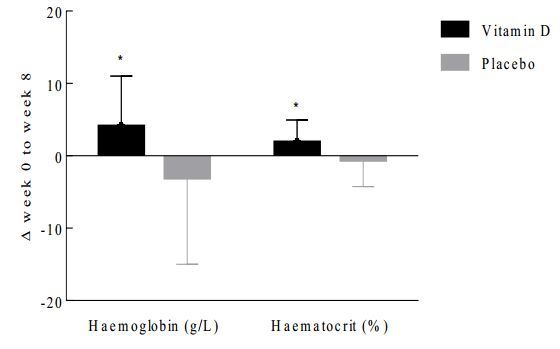Iron increased slightly by small amount of Vitamin D for a short time – RCT
Vitamin D3 supplementation for 8 weeks leads to improved haematological status following the consumption of an iron-fortified breakfast cereal: a double-blind randomised controlled trial in iron-deficient women. (1-2)
Br J Nutr. 2019 Mar 1:1-31. doi: 10.1017/S0007114519000412
Salma F Ahmad Fuzi1 2, Sohail Mushtaq1
From the Faculty of Medicine, Dentistry and Life Sciences, University of Chester, Parkgate Road, Chester, UK, CHI 4BJ
From the Department of Nutrition and Dietetics, Faculty of Medicine and Health Sciences, Universiti Putra Malaysia, Selangor, Malaysia
Address correspondence to Associate Professor Sohail Mushtaq, Faculty of Medicine, Dentistry and Life Sciences, University of Chester, Parkgate Road, Chester, UK, CHI 4BJ. Tel: +44 (0)124 4513367, Fax: +44 (0)124511310, Email address: s.mushtaq@chester.ac.uk
📄 Download the PDF from Sci-Hub via VitaminDWiki

Accepted manuscript
ABSTRACT
The effect of 38 pg (1500 IU) daily vitamin D3 supplementation, consumed with an iron-fortified
breakfast cereal for 8 weeks, on haematological indicators in iron-deficient female subjects was
investigated. Fifty iron-deficient subjects (plasma ferritin concentration < 20 pg/L; mean age ± SD:
27.4 ± 9.4 years) were randomised to consume an iron-fortified breakfast cereal containing 9 mg of
iron daily, with either a vitamin D3 supplement or placebo. Blood samples were collected at
baseline, interim (4 weeks) and post-intervention (8 weeks) for measurement of iron and vitamin D
status biomarkers. The effect of intervention was analysed using mixed-model repeated measures
ANOVA. Significant increases were observed in two main haematological indices: haemoglobin
concentration and haematocrit level from baseline to post-intervention in the vitamin D group, but
not in the placebo group. The increase from baseline to post-intervention in haemoglobin
concentration in the vitamin D group (135 ± 11 to 138 ± 10 g/L) was significantly higher compared
to the placebo group (131 ± 15 to 128 ± 13 g/L) (P=0.037). The increase in haematocrit level from
baseline to post-intervention was also significantly higher in the vitamin D group (42.0 ± 3.0 to 43.8
± 3.4%) compared to the placebo group (41.2 ± 4.3 to 40.7 ± 3.6%) (P=0.032). Despite the non-
significant changes in plasma ferritin concentration, this study demonstrates that 38 pg
supplemental vitamin D, consumed daily, with iron-fortified breakfast cereal led to improvement in
haemoglobin concentration and haematocrit levels in women with low iron stores. These findings
may have therapeutic implications in the recovery of iron status in iron-deficient populations at a
healthcare level.
